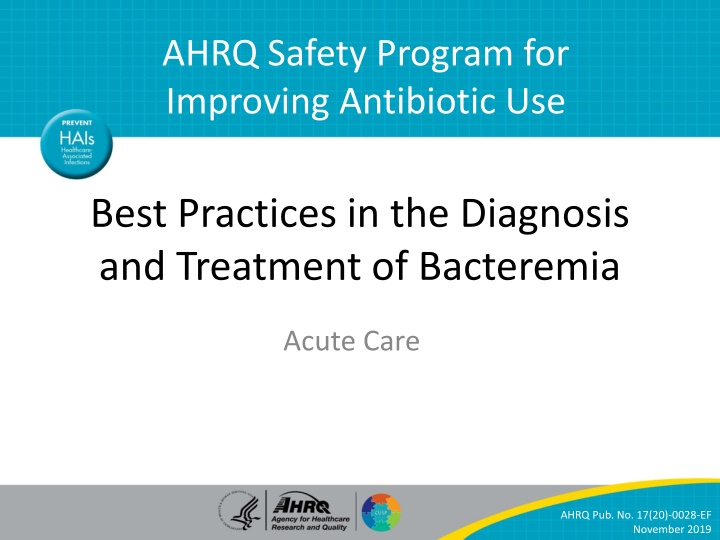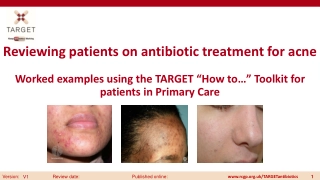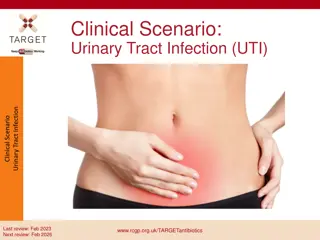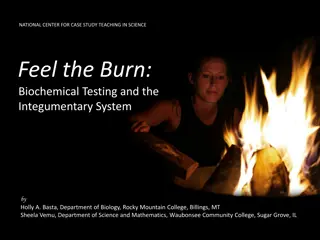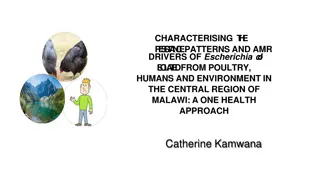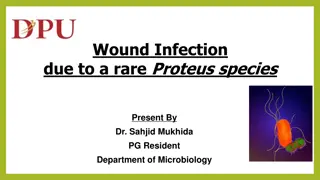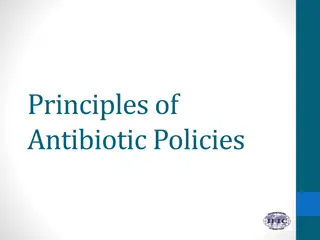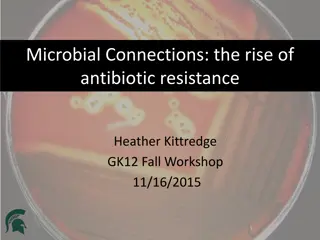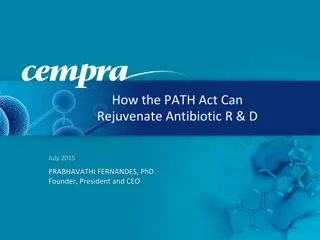Best Practices for Managing Bacteremia and Antibiotic Use
This resource highlights best practices for managing bacteremia and improving antibiotic use in acute care settings. It covers recommendations for blood culture collection, organism-specific management, de-escalation of antibiotic therapy, and duration of antibiotic therapy. The content also discusses the four moments of antibiotic decision-making and provides guidance on obtaining appropriate blood cultures and interpreting positive blood culture results, including example organisms and classification.
Download Presentation

Please find below an Image/Link to download the presentation.
The content on the website is provided AS IS for your information and personal use only. It may not be sold, licensed, or shared on other websites without obtaining consent from the author.If you encounter any issues during the download, it is possible that the publisher has removed the file from their server.
You are allowed to download the files provided on this website for personal or commercial use, subject to the condition that they are used lawfully. All files are the property of their respective owners.
The content on the website is provided AS IS for your information and personal use only. It may not be sold, licensed, or shared on other websites without obtaining consent from the author.
E N D
Presentation Transcript
AHRQ Safety Program for Improving Antibiotic Use Best Practices in the Diagnosis and Treatment of Bacteremia Acute Care AHRQ Safety Program for Improving Antibiotic Use Acute Care AHRQ Pub. No. 17(20)-0028-EF November 2019 Bacteremia
Objectives 1. Review recommendations for appropriate blood culture collection. 2. Develop organism-specific management recommendations for Gram-negative and Gram- positive bacteremia. 3. Discuss opportunities for de-escalation of antibiotic therapy for bacteremia. 4. Discuss reasonable durations of antibiotic therapy for common organisms causing bacteremia. AHRQ Safety Program for Improving Antibiotic Use Acute Care 2 Bacteremia
The Four Moments of Antibiotic Decision Making 1. Does my patient have an infection that requires antibiotics? 2. Have I ordered appropriate cultures before starting antibiotics? What empiric therapy should I initiate? 3. A day or more has passed. Can I stop antibiotics? Can I narrow therapy or change from IV to oral therapy? 4. What duration of antibiotic therapy is needed for my patient's diagnosis? AHRQ Safety Program for Improving Antibiotic Use Acute Care 3 Bacteremia
Obtaining Appropriate Blood Cultures1,2 Severe sepsis upon admission Cholangitis, meningitis, pyelonephritis, severe pneumonia, suspected endocarditis or endovascular infection, vertebral osteomyelitis/discitis, severe skin and soft tissue infections, systemic infection and asplenia, suspected catheter-related bloodstream infection New fever (T 38.5 C [>101.2 F]), suspected infection and no previous blood cultures (BC) within 48 hours Two sets of peripheral BC (each set with one aerobic and one anaerobic bottle) BC are not indicated since low yield If known source, culture suspected source New infectious process not meeting above criteria Persistent fever and two sets of negative BC within 48 hours BC likely not warranted For low grade fever or leukocytosis only, consider monitoring first and assessing for other contributing factors Isolated tachycardia, leukocytosis, hypotension, fever AHRQ Safety Program for Improving Antibiotic Use Acute Care 4 Bacteremia
Interpretation of Positive Blood Cultures Example organisms Classification What to do Staphylococcus aureus Gram-negative rods Candida spp. Extremely unlikely to be a contaminant ALWAYS treat Coagulase-negative staphylococci Corynebacterium spp. Diphtheroids Usually do not treat Exception: indwelling hardware, signs of infection, & > 1 positive blood culture Usually a contaminant Evaluate for possible source (e.g., oral, gastrointestinal, endocarditis), signs of infection, & > 1 positive blood culture Viridans group streptococci, Enterococcus spp. A contaminant about half the time AHRQ Safety Program for Improving Antibiotic Use Acute Care 5 Bacteremia
Enterobacteriaceae Bacteremia: Diagnosis Enterobacteriaceae = most common organisms include E. coli, Klebsiella spp., Enterobacter spp., Serratia spp., Citrobacter spp. Generally identified as lactose fermenters in laboratory reports Always identify the source of bacteremia Commonly urine, intra-abdominal, pulmonary (in hospitalized patients) Translocation from the gut due to gut disruption or procedure Catheter-related if central line in place AHRQ Safety Program for Improving Antibiotic Use Acute Care 6 Bacteremia
Enterobacteriaceae Bacteremia: Antibiotic Therapy Narrow therapy based on susceptibility results Considerations for IV to PO conversion:3 Patient has an appropriate clinical response Appropriate source control preferred Patient needs to be able to take and absorb oral antibiotics Active oral antibiotic needs to have adequate oral bioavailability oFluoroquinolones, trimethoprim/sulfamethoxazole AHRQ Safety Program for Improving Antibiotic Use Acute Care 7 Bacteremia
Enterobacteriaceae Bacteremia: Duration of Therapy Traditional treatment duration has been 10 14 days Randomized controlled trial including 604 patients with Gram-negative bacteremia randomized to receive either 7 days or 14 days of treatment4,5 Most of the organisms were Enterobacteriaceae For patients who were afebrile, hemodynamically stable, and achieved appropriate source control, 1 week of antibiotic therapy was sufficient. AHRQ Safety Program for Improving Antibiotic Use Acute Care 8 Bacteremia
Enterobacteriaceae Bacteremia: Followup Cultures Minimal role for followup blood cultures in Gram- negative bacteremia Study evaluating 500 episodes of bacteremia6 77% had at least one followup blood culture Only eight cultures grew Gram-negative rods Do not need to obtain routinely Consider if persistent symptoms despite source control or suspicion of endovascular infection AHRQ Safety Program for Improving Antibiotic Use Acute Care 9 Bacteremia
Extended-Spectrum Beta-Lactamases Most commonly seen in E. coli, Klebsiella spp., Proteus spp. Many microbiology laboratories are not performing ESBL confirmation testing Agents of first choice for invasive infections are carbapenems, based on the results of a multicenter randomized trial7 Can consider fluoroquinolones or trimethoprim/ sulfamethoxazole if susceptible Can consider piperacillin/tazobactam, if susceptible, for milder infections like cystitis Ceftriaxone, cefepime, and aztreonam not recommended AHRQ Safety Program for Improving Antibiotic Use Acute Care 10 Bacteremia
AmpC Beta-Lactamases Most commonly seen in Enterobacter species Induced by exposure to third-generation cephalosporins: do NOT use these agents to treat Enterobacter species even if reported as susceptible Microbiology laboratories do not test for AmpC beta- lactamases For invasive Enterobacter species infections, avoidance of third-generation cephalosporins is recommended Consider cefepime,8,9 carbapenems, fluoroquinolones, or trimethoprim/ sulfamethoxazole, if susceptible AHRQ Safety Program for Improving Antibiotic Use Acute Care 11 Bacteremia
Carbapenem-Resistant Enterobacteriaceae CRE are resistant to at least one carbapenem e.g., ertapenem, meropenem, imipenem/cilastatin, or doripenem About half the time they produce carbapenemase enzymes10 KPC carbapenemases are the most common carbapenemases in the United States Consult infectious diseases for treatment recommendations Some general rules:11-14 Beta-lactam/beta-lactamase inhibitor combination agents (e.g., ceftazidime/avibactam, meropenem/vaborbactam), generally have good activity against CRE and are the preferred treatment o Must obtain susceptibility testing Other options if CRE-active beta-lactam/beta-lactamase inhibitor combination agents are not available: extended-infusion meropenem or imipenem/cilastatin therapy if MIC is 8 mcg/mL PLUS a second agent based on in vitro susceptibility results AHRQ Safety Program for Improving Antibiotic Use Acute Care 12 Bacteremia
Pseudomonas Bacteremia12 Blood cultures growing oxidase-positive, non-lactose-fermenting Gram-negative rods Determine the source Commonly pulmonary, catheter/hardware, urine, wound Source control whenever possible Antibiotic therapy12 Piperacillin/tazobactam, cefepime, ceftazidime, carbapenems (not ertapenem), fluoroquinolones (not moxifloxacin), aminoglycosides Data do not support the use of combination therapy over monotherapy o Aminoglycoside monotherapy not recommended (Exception: lower urinary tract infections) If isolate is multidrug-resistant, consider infectious diseases consult Duration: 10 14 days in most cases AHRQ Safety Program for Improving Antibiotic Use Acute Care 13 Bacteremia
Staphylococcus aureus Bacteremia: Diagnosis Determining the source of S. aureus bacteremia and whether there has been metastatic spread are of critical importance15 Based on history and physical exam, imaging should be obtained Concomitant vertebral osteomyelitis/discitis/epidural abscesses are not uncommon AHRQ Safety Program for Improving Antibiotic Use Acute Care 14 Bacteremia
Staphylococcus aureus Bacteremia: Diagnosis13 All patients must have echocardiography to assess for endocarditis Transesophageal echocardiogram (TEE) is more sensitive than transthoracic echocardiogram (TTE) in detecting smaller vegetations16 Most patients should receive TEE15 o Patients at low risk for endocarditis in whom short-course therapy is desired o Patient at high risk for cardiac complications (e.g., prosthetic valves, permanent cardiac devices, cardiac conduction abnormalities, prolonged bacteremia or fever) AHRQ Safety Program for Improving Antibiotic Use Acute Care 15 Bacteremia
Staphylococcus aureus Bacteremia: Management Blood cultures should be obtained to demonstrate clearance of bacteremia15 Source control is essential Remove hardware Debride abscesses Infectious diseases consultation17 AHRQ Safety Program for Improving Antibiotic Use Acute Care 16 Bacteremia
Staphylococcus aureus Bacteremia: Management Uncomplicated15 Endocarditis excluded with a TEE o In select cases a very good quality TTE suffices No implanted prosthetic devices Followup blood cultures are negative for S. aureus Patient defervesces within 72 hours of initiating effective therapy Patient has no localizing signs or symptoms of metastatic staphylococcal infection MSSA Complicated All other cases AHRQ Safety Program for Improving Antibiotic Use Acute Care 17 Bacteremia
MSSABacteremia: Management MSSA should be treated with anti-staphylococcal penicillins (oxacillin, nafcillin) or cefazolin Cefazolin is associated with fewer side effects but patients with deep-seated infections may develop resistance18,19 Vancomycin is associated with a higher failure rate and should not be used for convenience20,21 Strongly consider desensitization for patients with serious penicillin allergies who cannot tolerate cephalosporins AHRQ Safety Program for Improving Antibiotic Use Acute Care 18 Bacteremia
MRSA Bacteremia: Management Vancomycin still considered by most to be the agent of first choice22 Daptomycin can be considered in patients with renal toxicity due to vancomycin or if the vancomycin MIC is greater than 1.5 mcg/mL23 Higher doses recommended If bacteremia persists despite source control for more than 5 7 days or if patient is deteriorating clinically, salvage regimens may be required AHRQ Safety Program for Improving Antibiotic Use Acute Care 19 Bacteremia
S. aureus Bacteremia: Management18,20 The addition of gentamicin is not recommended for S. aureus bacteremia or native valve endocarditis22,24 It is associated with nephrotoxicity in the absence of clinical benefit25 The routine addition of rifampin is not recommended for S. aureus bacteremia or native valve endocarditis22,26 Consider in consultation with infectious disease specialists when the source of bacteremia is a prosthetic joint or spinal hardware oRifampin should not be initiated until after blood cultures have cleared The addition of gentamicin and rifampin is recommended for prosthetic valve endocarditis22 AHRQ Safety Program for Improving Antibiotic Use Acute Care 20 Bacteremia
S. aureus Bacteremia: Duration of Therapy All durations should be calculated from the day of the first negative blood culture or obtainment of source control, whichever is later Uncomplicated S. aureus bacteremia: 14 days Complicated S. aureus bacteremia: 28 42 days Osteomyelitis: 42 days at a minimum Right-sided endocarditis Injecting drug users with MSSA and minimal comorbidities, no hardware, no embolic disease other than septic pulmonary emboli: 14 days oxacillin/nafcillin Everyone else: 28 42 days Left-sided endocarditis: 42 days (or more) AHRQ Safety Program for Improving Antibiotic Use Acute Care 21 Bacteremia
Enterococcal Bacteremia: Diagnosis Microbiology E. faecalis o Community-acquired infections o Almost universally susceptible to ampicillin E. faecium o Hospital-acquired infections o Often ampicillin and vancomycin resistant (VRE) Enterococci spp. are generally of low virulence but can form biofilms and persist on catheters and prosthetic material AHRQ Safety Program for Improving Antibiotic Use Acute Care 22 Bacteremia
Enterococcal Bacteremia: Diagnosis Enterococcus growing in the blood falls into four general categories 1. Contaminant (likely from skin) 2. Bacteremia from translocation in a patient post-procedure (usually biliary) or with gut disruption (e.g., mucositis) 3. Bacteremia related to an infected source: commonly UTI/prostatitis and biliary tract infection 4. Endocarditis27 o Consider in settings of persistent bacteremia, prosthetic valves, or presentations consistent with endocarditis Source control whenever possible Minimal role for followup blood cultures if source is known and controlled AHRQ Safety Program for Improving Antibiotic Use Acute Care 23 Bacteremia
E. faecalis Bacteremia: Management Ampicillin (1st line) and vancomycin (2nd line) are not bactericidal Combination therapy with gentamicin is bactericidal Newer data suggest combination of ampicillin and ceftriaxone is bactericidal When is combination therapy needed?28,29 Endocarditis: yes o Failure rates up to 40% with monotherapy o 4 6 weeks of IV therapy Other infections: no evidence of benefit Infectious diseases consultation is recommended for endocarditis due to E. faecalis AHRQ Safety Program for Improving Antibiotic Use Acute Care 24 Bacteremia
E. faecium Bacteremia: Management Treat with ampicillin or vancomycin if susceptible Treat with linezolid or daptomycin if not susceptible to ampicillin or vancomycin Infectious diseases consult recommended for VRE bacteremia or endocarditis AHRQ Safety Program for Improving Antibiotic Use Acute Care 25 Bacteremia
Summary The diagnosis and treatment of bacteremia varies based on the causative organism Ensure appropriate blood culture collection criteria are being used Always identify the likely source and proceed with source control if a lingering source has been identified, whenever possible Select the narrowest spectrum agents and shortest duration of therapy that has been shown to be efficacious AHRQ Safety Program for Improving Antibiotic Use Acute Care 26 Bacteremia
Disclaimer The findings and recommendations in this presentation are those of the authors, who are responsible for its content, and do not necessarily represent the views of AHRQ. No statement in this presentation should be construed as an official position of AHRQ or of the U.S. Department of Health and Human Services. Any practice described in this presentation must be applied by health care practitioners in accordance with professional judgment and standards of care in regard to the unique circumstances that may apply in each situation they encounter. These practices are offered as helpful options for consideration by health care practitioners, not as guidelines. AHRQ Safety Program for Improving Antibiotic Use Acute Care 27 Bacteremia
References 1. Towns ML, Jarvis WR, Hsueh PR. Guidelines on blood cultures. J Microbiol Immunol Infect. 2010 Aug;43(4):347-9. PMID: 20688297. 2. Lee A, Mirrett S, Reller LB, et al. Detection of bloodstream infections in adults: how many blood cultures are needed? J Clin Microbiol. 2007 Nov;45(11):3546-8. PMID: 17881544. 3. Tamma PD, Conley AT, Cosgrove SE, et al. Association of 30-day mortality with oral step-down vs continued intravenous therapy in patients hospitalized with Enterobacteriaceae bacteria. JAMA Intern Med. 2019 Jan 22. [Epub ahead of print] PMID: 30667477. 4. Chotiprasitsakul D, Han JH, Cosgrove SE, et al. Comparing the outcomes of adults with Enterobacteriacea bacteremia receiving short-course versus prolonged- course antibiotic therapy in a multicenter, propensity score-matched cohort. Clin Infect Dis. 2018 Jan 6;66(2):172-7. PMID: 29190320. 5. Yahav D, Franceschini E, Koppel F, et al. Seven versus fourteen days of antibiotic therapy for uncomplicated Gram-negative bacteremia: a non-inferiority randomized controlled trial. Clin Infect Dis. 2018 Dec 11. [Epub ahead of print] PMID: 30535100. AHRQ Safety Program for Improving Antibiotic Use Acute Care Bacteremia 28
References 6. Canzoneri CN, Akhavan BJ, Tosur Z, et al. Follow-up blood cultures in Gram- negative bacteremia: are they needed? Clin Infect Dis. 2017 Nov;65(11):1776-9. PMID: 29020307. 7. Harris PNA, Tambyah PA, Lye DC, et al. Effect of piperacillin-tazobactam vs meropenem on 30-Day mortality for patients with E. coli or Klebsiella pneumoniae bloodstream infection and ceftriaxone resistance: a randomized clinical trial. JAMA. 2018 Sep;320(10):984-94. PMID: 30208454. 8. Tamma PD, Girdwood SC, Gopaul R, et al. The use of cefepime for treating AmpC -lactamase-producing Enterobacteriaceae. Clin Infect Dis. 2013 Sep;57(6):781-8. PMID: 23759352. 9. Siedner MJ, Galar A, Guzm n-Suarez BB, et al. Cefepime vs other antibacterial agents for the treatment of Enterobacter species bacteremia. Clin Infect Dis. 2014 Jun;58(11):1554-63. PMID: 24647022. 10. Guh AY, Bulens SN, Mu Y, et al. Epidemiology of carbapenem-resistant Enterobacteriaceae in 7 US communities, 2012-2013. JAMA. 2015 Oct;31(14):1479-87. PMID: 26436831. AHRQ Safety Program for Improving Antibiotic Use Acute Care Bacteremia 29
References 11. Morrill HJ, Pogue JM, Kaye KS, et al. Treatment options for carbapenem-resistant Enteriobacteriaceae infections. Open Forum Infect Dis. 2015 May;2(2):ofv050. PMID: 26125030. 12. Kaye KS, Pogue JM. Infections caused by resistant Gram-negative bacteria: epidemiology and management. Pharmacotherapy. 2015 Oct;35(10):949-62. PMID: 26497481. 13. Wunderink RG, Giamarellos-Bourboulis EJ, Rahav G, et al. Effect and safety of meropenem-vaborbactam versus best-available therapy in patients with carbapenem-resistant Enterobacteriaceae infections: The TANGO II randomized clinical trial. Infect Dis Ther. 2018 Dec;7(4):439-55. PMID: 30270406. 14. Tumbarello M, Trecarichi EM, Corona A, et al. Efficacy of ceftazidime-avibactam salvage therapy in patients with infections caused by Klebsiella pneumoniae carbapenemase-producing K. pneumoniae. Clin Infect Dis. 2019 Jan 18;68(3):355- 64. PMID: 29893802. 15. Cosgrove SE, Fowler VG Jr. Optimizing therapy for methicillin-resistant Staphylococcus aureus bacteremia. Semin Respir Crit Care Med. 2007 Dec;28(6):624-31. PMID: 18095226. AHRQ Safety Program for Improving Antibiotic Use Acute Care Bacteremia 30
References 16. Reynolds HR, Jagen MA, Tunick PA, et al. Sensitivity of transthoracic versus transesophageal echocardiography for the detection of native valve vegetations in the modern era. J Am Soc Echocardiogr. 2003 Jan;16(1):67-70. PMID: 12514637. 17. Bai AD, Showler A, Burry L, et al. Impact of infectious disease consultation of quality of care, mortality, and length of stay in Staphylococcus aureus bacteremia: results from a large multicenter cohort study. Clin Infect Dis. 2015 May 15;60(10):1451-61. PMID: 2501854. 18. Li J, Echevarria KL, Hughes DW, et al. Comparison of cefazolin versus oxacillin for treatment of complicated bacteremia caused by methicillin-susceptible Staphylococcus aureus. Antimicrob Agents Chemother. 2014 Oct;58(10):5117-24. PMID: 24936596. 19. Lee S, Choe PG, Song KH, et al. Is cefazolin inferior to nafcillin for treatment of methicillin-susceptible Staphylococcus aureus bacteremia? Antimicrob Agents Chemother. 2011 Nov;55(11):5122-6. PMID: 21825299. 20. Chang FY, Peacock JE Jr, Musher DM, et al. Staphylococcus aureus bacteremia: recurrence and the impact of antibiotic treatment in a prospective multicenter study. Medicine (Baltimore). 2003 Sep;82:333-9. PMID: 14530782. AHRQ Safety Program for Improving Antibiotic Use Acute Care Bacteremia 31
References 21. Stryjewski ME, Szczech LA, Benjamin DK Jr, et al. Use of vancomycin or first- generation cephalosporins for the treatment of hemodialysis-dependent patients with methicillin-susceptible Staphylococcus aureus bacteremia. Clin Infect Dis. 2007 Jan;44(2):190-6. PMID: 17173215. 22. Liu C, Bayer A, Cosgrove SE, et al. Clinical practice guidelines by the Infectious Diseases Society of America for the treatment of methicillin-resistant Staphylococcus aureus infections in adults and children. Clin Infect Dis. 2011 Feb;52(3): e18-55. PMID: 21208910. 23. Fowler VG Jr, Boucher HW, Corey GR, et al. Daptomycin versus standard therapy for bacteremia and endocarditis caused by Staphylococcus aureus. N Engl J Med 2006 Aug;355(7): 653-65. PMID: 16914701. 24. Baddour LM, Wilson WR, Bayer AS, et al. Infective endocarditis in adults: diagnosis, antimicrobial therapy, and management of complications: a scientific statement for healthcare professionals from the American Heart Association. Circulation. 2015 Oct;132(15):1435-86. PMID: 26373316. 25. Cosgrove SE, Vigliani GE, Fowler VG, et al. Initial low-dose gentamicin for Staphylococcus aureus bacteremia and endocarditis is nephrotoxic. Clin Infect Dis. 2009 Mar;48(6):713-21. PMID: 19207079. AHRQ Safety Program for Improving Antibiotic Use Acute Care Bacteremia 32
References 26. Thwaites GE, Scarborough M, Szubert A, et al. Adjunctive rifampicin for Staphylococcus aureus bacteraemia (ARREST): a multicentre, randomized, double- blind, placebo-controlled trial. Lancet. 2018 Feb;391(10121):668-78. PMID: 29249276. 27. Anderson DJ, Murdoch DR, Sexton DJ, et al. Risk factors for infective endocarditis in patients with Enterococcal bacteremia: a case-control study. Infection. 2004 Apr;32(2):72-7. PMID: 15057570. 28. Beganovic M, Luther MK, Rice LB, et al. A review of combination therapy for Enterococcus faecalis bloodstream infections and infective endocarditis. Clin Infect Dis. 2018 Jul 2;67(2):303-9. PMID: 29390132. 29. Graninger W, Ragette R. Nosocomial bacteremia due to Enterococcus faecalis without endocarditis. Clin Infect Dis. 1992 Jul;15(1):49-57. PMID: 1617073. AHRQ Safety Program for Improving Antibiotic Use Acute Care Bacteremia 33
